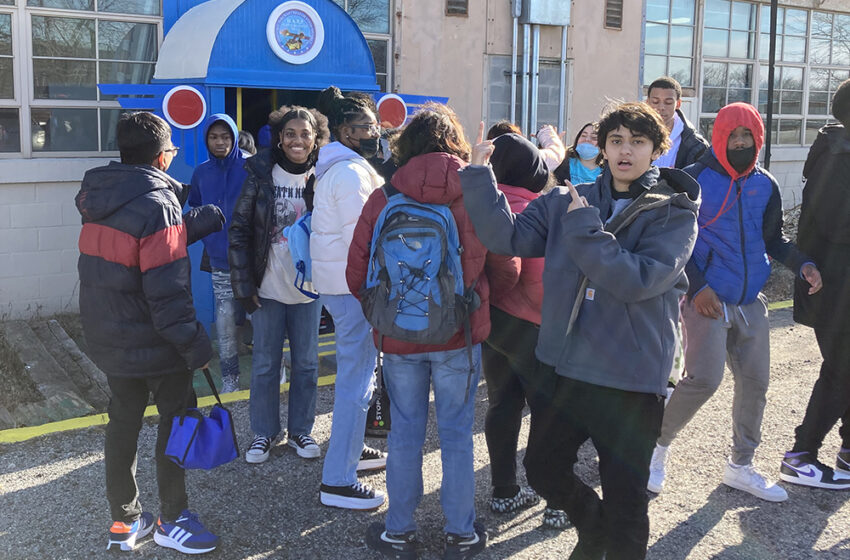Local H.S. Students Get a Lesson in Military History at Floyd Bennett

By Kami-Leigh Agard
How can schools introduce fresh perspectives with thoughtful exchanges about America’s fight for freedom with military veterans? This past Thursday, February 2, achieved just that, with students from New Visions Humanities IV Charter High School meeting up with military veterans of the Historical Aircraft Restoration Project (HARP). According to Jane Lake, New Visions STEM/living environment teacher and college advisor, this three-hour tour resulted in not just students learning about Floyd Bennett Field’s illustrious aviation history, checking out refurbished war planes, missiles, motors, the control tower, photos and more, but also America’s ascent to becoming the world’s super power. However, according to these students, though America’s history does document its labor pains, this tour instilled pride in being a product of what countless veterans fought for, with some even sacrificing their lives.

Floyd Bennett Field (FBF) was NYC’s first municipal airport. Later it became a World War II naval air station. Today, this area includes more than 1,300 acres of grassland, salt marshes, tidal mudflats, a marina, and the former airfield, including a control tower and terminal that is now the William Fitts Ryan Visitor Center (Ryan Visitor Center). FBF was a popular site for aviators, seeking to break records. Twenty-six around-the-world or transatlantic flights started or ended at FBF between 1931 and 1939, including historic and even fatal missions by Amelia Earhart, Jimmy Mattern, Wiley Post and Howard Hughes. Between 1941 and 1971, FBF served as New York’s Naval Air Station, playing an integral role in the defense of NYC and the U.S.A. at large.
Born in 1890, in Warrensburg, NY, Floyd Bennett was an American pioneer aviator who piloted the explorer Richard E. Byrd on the first successful flight over the North Pole on May 9, 1926. For this feat, both Bennett and Byrd received the U.S. Congressional Medal of Honor. In 1931, Floyd Bennett Airport was named for him.
Fast forward to today, walk into Floyd Bennett’s Hangar B and be prepared to be impressed by how these HARP veterans meticulously refurbished military airplanes, helicopters, missiles, old army jeeps, medic vehicles; and even how they built scaled versions of military war ships, airplanes and more used in World War I, World War II, D-Day and Korea. There is also a Wright Brothers exhibit, a functioning 1950s switch operation telephone board, and so much more.

Longtime Rockaway local, Paul Garcia, a U.S. Navy veteran and HARP volunteer, who led Thursday’s tour, said he got hooked 22 years ago after driving past the area one day. “I saw the airplanes while driving past Floyd Bennett, and I wanted to find out more. I was an aircraft mechanic when I was in the Navy, so of course I gravitated to the work here,” Garcia said.
New Visions High School students were inspired by the veterans’ passion to rebuild and restore Floyd Bennett’s history. The students were split up into two groups, where they got to physically enter the planes and get up-close information about each craft’s history.
Steven Xol-Quevedo, a Beach Channel campus student council representative for New Visions High School said, “I think it’s really cool that we get to learn how everything works, and amazingly see how these guys brought these machines back to life. It’s a huge project, yet they’ve been able to restore, get every single part that they need to rebuild each vehicle, then have it here to display for us.”
Students Ciara Baez and Chelsea Santiago shared that they were both inspired to further pursue their Navy service ambitions. Baez said, “When we heard that we were coming here, we weren’t that excited because we thought it was going to be boring, but it’s not as boring as we thought. It’s interesting to see how the planes evolved throughout history, and what each aircraft has been through.”
Santiago added, “Every airplane tells a story, and I think that keeping all these aircrafts here is definitely something that should be conserved. To think that this plane was flown during WWII is pretty awesome.
“It’s also great for the youth because when we get older, there’s gonna be kids asking us what happened during these wars. Then we can only show them what’s told in textbooks, but these military vehicles visually tell the history,” Santiago continued.
As for why New Visions teacher and college advisor Jane Lake, selected FBF’s Hangar B for students to visit, she shared, “History’s amazing, yet sometimes it’s challenging to bring it alive for students. World War I and World War II are so distant for a lot of the students. For them to understand that these military airplanes were flown by 18-year-olds, not much older than them, could be daunting. Also, to meet these veterans, who not just served, but now dedicate their time to refurbishing these aircrafts to educate their next generation is such an inspiration.
“Also, for the students to see how these veterans are mechanics bringing these aircrafts back to life is so valuable. Wood shop programs no longer exist in most high schools, so for them to be exposed to HARP’s work might prompt them to want to learn about how things mechanically work.”
Floyd Bennett Field’s Historical Aircraft Restoration Project (HARP) is staffed and operated by National Park Service volunteers. The airfield and former Naval Air Station are now a part of NPS’s Gateway Recreation Area in Brooklyn. Admission is free, but donations are accepted and more than welcome. Visitors are welcome Tuesdays, Thursdays and Saturdays, 10 a.m. to 2 p.m. For more info, visit: https://www.nps.gov/gate/learn/historyculture/historic-aircraft-at-hangar-b.htm


